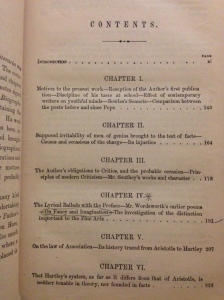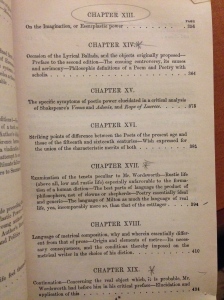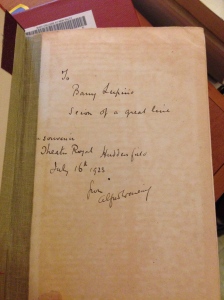Books allow us to enter a world of fantasy and mystery, but they can also take us back in time in our own world. The marks left behind in books can give us a glimpse into the past, and reveal the thoughts of those who have read them before us. They are evidence that stories live on and are referred to long after they have been published. In The Complete Works of Samuel Taylor Coleridge, published in 1884 by Harper & Brothers in Franklin Square, New York and edited by Professor W.G.T. Shedd, people have left annotations in the margins, providing insight into their thoughts and opinions on what is written inside this book.
The table of contents has stars and chapter titles or subtitles circled, signifying their importance to whomever circled and added the asterisks. If you look closely, it appears that whomever added these little notes to the table of contents was looking for information on William Wordsworth. Each chapter that is marked has some reference to Wordsworth and some about poetry. So, maybe this person was researching Wordsworth and the importance of poetry. Or maybe they wanted to learn more about Wordsworth’s criticism and have an explanation of poetry. The comment in the margin, “delightful stories”, is interestingly enough not in a chapter that was starred or circled. The “delightful stories” could be a declaration about poems that are about pleasure and not works of science and how they are “delightful”, or it could be a statement in reference to poems that have more to do with pleasure rather than works of science. Wordsworth and Coleridge were Romantic poets, so it would be appropriate to say that pleasure over science would be more “delightful”. The Romantic movement was a rebellion against science and logic, instead it looked toward beauty, nature, and God. So, if the comment was remarking on the Romantic Era, then it would be appropriate to say that they are “delightful stories” compared to writings about science!
One other marginalia that I found was in a book called Shakespeare: The Man and his Stage by E.A.G. Lamborn and G.B. Harrison. It was published in 1923 by the London Oxford University Press, Humphrey Milford. The marginal note can be found tapped in on the front page of the book. Due to the handwriting, I am not sure what the entire inscription says. So, in order to not interpret it incorrectly I am adding a dash where I am not sure what the rest of the word says. The note appears to be a letter addressed to a Barry Lu- and from a man named Alfred S-. The note was written on July 16, 1923, and above the date it says “Theatre Royal Huddersfield”. The book may have been a gift to Barry, as evident by the word “souvenir”. The letter says something like “s- of a great time”. With some research, Barry’s last name could be “Lupino”. Barry Lupino was a British film actor, producer, and comedian. If this is the man that the note is addressed to, then it would make sense that he would be receiving a book like this. If not, then I apologize for any false information!
– Allyson Macci



